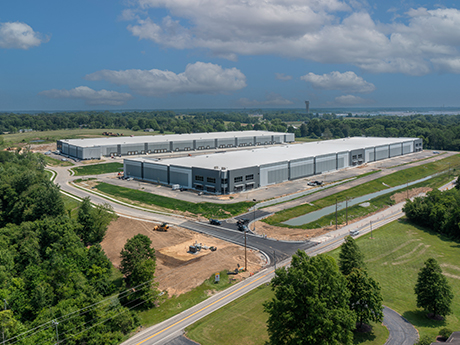By Andrew Jacob, Colliers
The Cincinnati/Northern Kentucky industrial market demonstrated notable resilience in the second quarter of 2025, balancing strong long-term fundamentals with cautious short-term sentiment. Amid national headlines of slowing industrial demand and heightened uncertainty, the region continues to distinguish itself with a combination of strategic location, steady demand and disciplined development.
Market fundamentals
At the close of the second quarter, the market’s total inventory stood at approximately 293.6 million square feet, supported by a healthy vacancy rate of 5.2 percent, which remains below the national average of 7.1 percent. Bulk warehouse asking rates have remained relatively steady at $5.95 per square foot, reflecting a market rebalancing after several years of oversupply from robust development activity.

In contrast, flex space asking rates continue to climb, now averaging $8.11 per square foot. This upward pressure is fueled by a scarcity of new supply — driven by land constraints and elevated construction costs.
The market recorded 539,000 square feet of positive net absorption in the second quarter, bringing the year-to-date total to over 1 million square feet. This consistent absorption highlights enduring occupier demand despite broader caution in the national market.
New construction activity continued at a measured pace, with 2 million square feet underway, entirely comprised of build-to-suit projects — marking the first time in decades without speculative development in the pipeline. Two speculative buildings developed by Ambrose Property Group were delivered this quarter in Burlington, Kentucky, with additional buildings planned but not yet started throughout the market.
Although the absence of speculative development highlights a cautious approach by developers, this dynamic could shift rapidly if tenant demand accelerates, especially given the lack of active projects currently in the pipeline.
Notable transactions
Leasing and sales activity in the second quarter further underscored the resilience and appeal of the Cincinnati/Northern Kentucky industrial market. On the leasing side, Trew committed to 304,000 square feet at 5389 E. Provident Drive, while iDrive leased 134,000 square feet at 3770 Symmes Road, and Triace USA took 123,000 square feet at 185 Commerce Drive. These transactions reflect steady occupier demand in the northern Cincinnati market.
The sales market also demonstrated robust investor interest. NorthPoint Development acquired a 387,200-square-foot facility at 1765 Worldwide Blvd. from IDI Logistics for $75 per square foot. The Steiner Group purchased 6283 TriRidge Blvd. at approximately $61 per square foot, and Gibraltar Industries acquired a 105,000-square-foot building at 7108 Shona Drive for $116 per square foot.
These sales highlight the ongoing scarcity of high-quality, move-in-ready industrial product, which continues to attract strong competition from both owner-users and investors seeking strategic, well-located assets in a constrained supply environment.
Broader trends, outlook
Industry sentiment, while moderately bullish, has softened slightly compared with earlier in the year. According to regional broker and owner surveys, the market began the second quarter with stronger optimism, but rising geopolitical tensions, tariff discussions and softening consumer demand have introduced caution. Respondents rated their sentiment at an average of about 6 out of 10, indicating confidence tempered by risk awareness.
In Northern Kentucky, elevated vacancy and limited new tenant demand, especially in larger spaces, have challenged the submarket. Significant blocks of space returning to the market in coming quarters — such as the former Wayfair and Levi facilities — could push vacancy higher before improvement is expected, likely in 2026.
Conversely, northern Cincinnati has maintained steady demand, particularly in small-to-mid-sized segments, supported by land constraints and no new speculative construction.
From an occupier perspective, uncertainty is driving more conservative strategies. Companies continue to consolidate operations, sublease excess space and negotiate flexible lease terms rather than commit to long-term expansions. The lease-versus-own debate has intensified as well, with occupiers — particularly those investing in automation — valuing ownership for the customization, cost predictability and control it offers.
On the development side, build-to-suit remains the preferred mode of new construction. Notable build-to-suit projects under construction include Hit Promotional Products’ 800,000-square-foot and Schneider Electric’s 446,000-square-foot sites in Fairfield, Ohio, along with Niagara Bottling’s 436,800-square-foot and Chick-fil-A’s 270,000-square-foot sites in Elsmere, Kentucky.
Looking ahead
While short-term risks remain — including potential increases in sublease space, aging and functionally obsolete inventory and geopolitical uncertainty — the long-term fundamentals of the Cincinnati/Northern Kentucky industrial market are compelling. The region’s strategic location within a day’s drive of 60 percent of the U.S. population, robust transportation infrastructure and disciplined development pipeline position it for continued success.
As we progress through 2025, occupiers and investors are expected to focus on risk management, operational efficiency and long-term relationships. Speculative development will likely remain limited, while build-to-suit activity and ownership opportunities will attract committed users seeking control and customization.
In a market defined by resilience and prudence, Cincinnati/Northern Kentucky stands out as a reliable industrial hub. Balancing short-term caution with an eye toward long-term fundamentals, the region remains a solid choice for occupiers, developers and investors alike.
Andrew Jacob is a senior associate of industrial services with Colliers. This article originally appeared in the July 2025 issue of Heartland Real Estate Business magazine.


